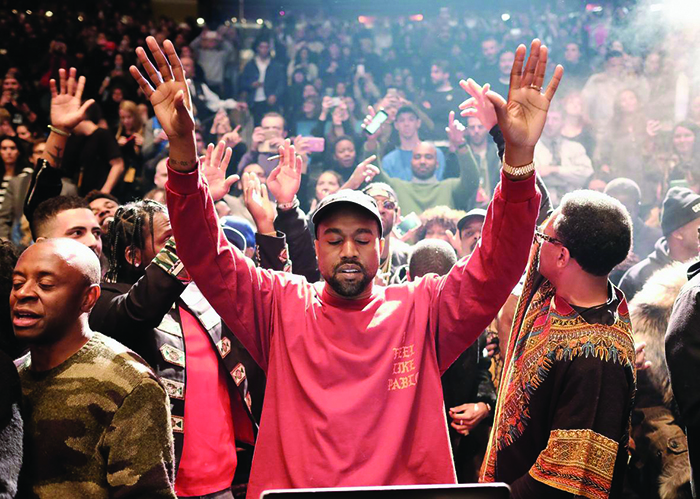L.A.-based music manager Todd C. Roberts can pinpoint precisely when he knew Kanye West was “marketing on another plane entirely.” It was 2016, when hip-hop’s chief provocateur promoted his album The Life of Pablo with a series of pop-up shops—which he announced through tweets that included a map dotted with the 21 locations around the world.
Roberts, co-founder of creative advisory Creative Cabal, went to check out the artist’s L.A. shop, where a throng of fans all but barricaded the entrance. Once inside, he discovered the “shop” was actually just a single rack of T-shirts with Pablo art on them. And forget about any attempt at customer service: “You could not touch the merchandise,” he recalls with a laugh. “You were not allowed to. You had to just pay $65 for a T-shirt and get the f*** out.”
The pseudo-hostile retailing only fueled interest in the music. Songs from The Life of Pablo were streamed 400 million times in the six weeks it was exclusively available on Tidal.
Cultivating a feeling of exclusivity, real or perceived, is a signature gambit for content marketers—and auteurs—in the music industry. It’s also one of the many strategies worth pilfering by content marketers working in industries outside the pop music sphere. Sure, you say, but that’s Kanye Freaking West. Well, yes. And you’re probably not going to open a string of pop-up boutiques to sell T-shirts with catchphrases from your latest e-book or blog post. But a lot of your customers (and prospects) may be just as eager to get their hands on your content. So take a cue from Yeezy—make a video, hit the social channels, do whatever it takes to make your customers feel like they’re part of a cool cabal with exclusive access to insider info.
Turning music marketing up to 11
There’s a reason content marketing in the music industry so often feels maverick these days. The Internet Age has not been kind to its business model. As the margins on song and album sales plummeted, and virtual streaming went mainstream, all but the top tier of performers had to tour extensively to see any real profits. So it’s no shocker that they’re turning up the content marketing.
In a way, the music industry was an early adopter of content marketing, with its go-to tool: the music video. The format — both in short and long versions — has a storied past that stretches back to The Beatles and has since attracted everyone from David Bowie (with Oscar winner Tilda Swinton, no less) to Chance the Rapper. Content marketing continues to offer the music industry new pathways to revenue generation — not to mention customer loyalty and engagement — that connect with consumers in ways that feel both authentic and organic.
“Artists are realizing that that 5-inch slab of carbonate called a CD is not the be-all-end-all,” says Cary Baker, who helped rockers R.E.M. ascend to global fame in the 1980s as vice president of publicity at I.R.S. Records. “Doing other [content-related] things—like videos and documentaries—is a smart way to promote your music,” says Baker, now owner of conqueroo, an L.A. music publicity agency.
“The gatekeepers—basically those in the established record label system—have moved along,” says Alan Miller, co-founder of seminal (now-defunct) rock magazine Filter and now co-founder of self-described boutique culture agency Collide in Los Angeles. “And now there’s no barrier to entry when it comes to marketing in music. Everyone is a Twitter handle away from creating something amazing. You’re seeing smart artists evolve into doing things beyond music that are equally creative—and oftentimes even more lucrative.”
Indeed, some of music’s splashiest recent moments fall under the umbrella of savvy content marketing. We take a look at some of those ultra-buzzy campaigns and a few lessons content marketing professionals can extract from them.

An Ocean of print opportunity
By now, most content marketers realize reports of print’s demise have been greatly exaggerated. Alternative hip-hop star Frank Ocean got the memo. In August 2016, he promoted his Blonde album by launching a custom magazine, Boys Don’t Cry, available via pop-up shops in New York City, London, Chicago and Los Angeles. Nearly every contributor to the mag — including A$AP Rocky, Kanye West (man, that guy gets around), Rick Rubin and Tyler the Creator—gave the release a shout-out on social media on its release date, creating a mighty cyclone of influencer marketing around the project.
Pitchfork reported that Ocean gave away the magazine for free, but prices for it hit $1,000 on eBay. And the magazine is still working it for Ocean, as fans continue to prize the premier content marketing product, with unopened copies priced up to $500 on eBay.

Unlike a billboard, a magazine uses storytelling and first-person access to the most personal thoughts and styles of the musician, which can only help build demand and relationships between a star and audience. Ocean saw his record and ticket sales go through the roof. Blonde debuted at No. 1 and appeared on an overwhelming majority of critics’ “best of the year” lists.
Lessons worth learning:
- Niche marketing builds brand loyalty
- Collaborators put influencer marketing on steroids
- Print is premium and a friend to sales

Making Hay of it all
Colin Hay, former frontman for Men at Work, took the standard-issue video to new lengths with an 84-minute documentary. Waiting for My Real Life chronicles the Aussie’s rocky journey from ’80s pop icon to working solo artist. The announcement of the film was rolled out by video trailers posted to Facebook, where a majority of Hay’s core fan base congregates.
“[Long-form] video is becoming a more popular way to get attention,” says Baker, who represents Hay. “And in this era of mass video consumption, it also has the power to humanize an artist by telling compelling stories—in a way that shorter music videos simply cannot.”
Yes, shooting a documentary film is both time-consuming and requires significant capital. But by zooming in on stories that reveal the artist’s finer qualities or deeds, a good promotional documentary tethers an artist to his or her fans emotionally and can also validate the veracity of a fan’s admiration. In Hay’s case, the singer’s dogged perseverance in a tough industry leads viewers to wonder how such an incredible person and performer could have languished in relative obscurity for so long. Hay’s story sells his music.
Lessons worth learning:
- High-quality video and personal storytelling drive fan engagement
- Take the time to tell the story right
- Authenticity drives the brand and the bottom line
“A good promotional doc tethers an artist to his or her fans emotionally and can also validate the veracity of a fan’s admiration, by zooming in on stories that reveal the artist’s finer qualities or deeds.”

Kanye bares all for marketing
The Kanye West marketing blitz of 2016 included the pop-ups, a fashion-show-as-listening-party staged during New York Fashion Week, and the artist’s eccentric use of Twitter, like endless tweets filled with a torrent of links to alternate versions of songs on The Life of Pablo.

At the New York Fashion Week show for his Yeezy brand in February 2016, West debuted a dramatic trailer for a video game depicting his late mother entering the gates of heaven. And that June, West dropped a video for the song “Famous” that doubled as a masterstroke of viral content marketing. In the video, 12 famous people — including Donald Trump, Anna Wintour, Bill Cosby, Rihanna and Chris Brown — lie naked together in a big bed (almost all were computer generated). Splicing that footage were a surreal voiceover, sound effects and celestial imagery worthy of a David Lynch film. Vanity Fair said it might be “his most thought-provoking work yet.” And 8,000 people watched its premiere on a 100-foot screen at the L.A. Forum.
Love him or hate him, you must respect ’Ye’s incredible content game.
Lessons worth learning:
- Great content marketing can catalyze conversations—and sales
- Authenticity rules
- Go big or go home

Beyonce’s surprise strategy
Queen Bey ruled content marketing in music in 2016 with her “visual album”: Lemonade,—a soulful, 60-minute film that was one of the prettiest and most provocative pieces of filmmaking to surface that year. It aired on HBO on the same day the album became available for streaming. According to TV by the Numbers, the video pulled in 787,000 viewers in the 18 to 49 demographic — not too shabby considering it was up against the NBA playoffs. The album went on to sell just over a million copies by the first week of June, making it one of only four albums in 2016 to pass the magic million mark.

The superstar’s stunning turn at the 2017 Grammy Awards, where she performed heavily pregnant in a gold gown and headdress worthy of a mythical goddess, was later immortalized on Beyonce.com in large-scale photos. Along with the style showcase were a tally of her Grammy wins and scenes from the performance.
Content is the marketing gift that keeps artists top of mind and music moving.
Lessons worth learning:
- Quality over quantity
- Teasers are great, long-form surprises are better
- Slice and dice that content




